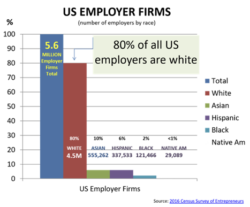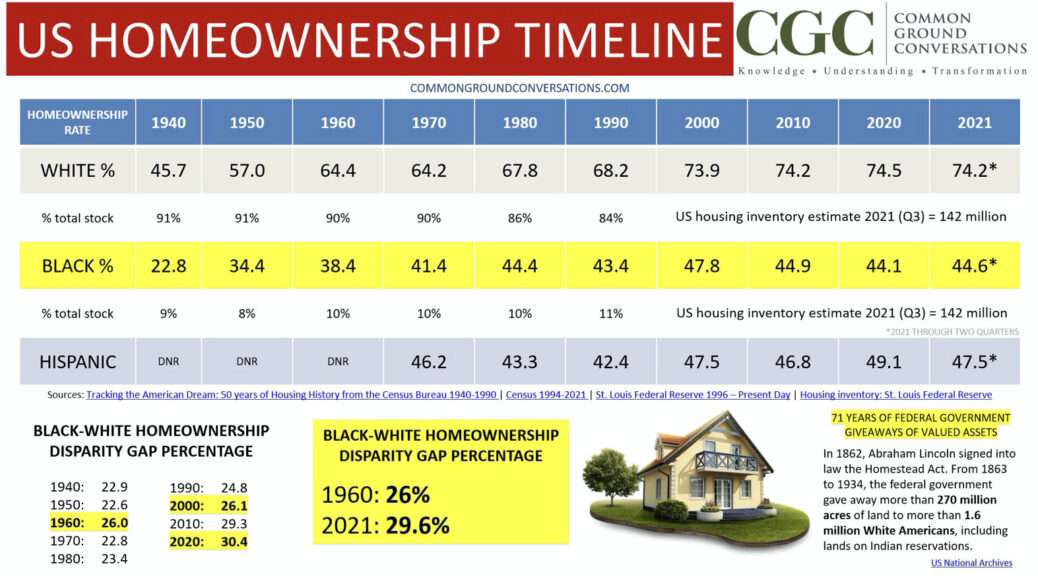Consider the tremendous economic opportunity inherent in a single percentage point. Think about the enormous economic impact of moving the needle of progress along a pathway toward racial equity by just a single percentage point.
First, let’s define the term, “racial equity” to establish a common frame of reference and understanding. For many, racial equity refers to equitable access to resources and opportunity. That definition is accurate but incomplete. In the realm of homeowners, business owners and investors, “equity” refers to “ownership.” Equitable ownership of lands, homes, businesses and intellectual property are valued assets that can be passed onto future generations as “generational wealth.” This is a more complete definition of racial equity in measurable terms.
Therefore, to achieve racial equity in terms of measurable wealth assets, or an equitable share of the American dream of prosperity, we must invariably start with developing equitable access to resources and opportunity for marginalized populations of color that are disconnected from the 21st century knowledge-based, tech-driven globally competitive Innovation Economy. But the destination of any racial equity pathway must lead to measurable ownership of valued assets: lands, homes, businesses and intellectual property. This formula should be at the center of any economic strategy if the priority is to produce outcomes that benefit America’s most vulnerable populations.
For example, let’s examine the power of 1 percent in the landscape of employer firms. Employer firms serve as a useful racial equity lens because the issues of income inequality, wage discrimination, glass ceilings for women and minorities, employment and unemployment, hiring and firing practices, are all influenced by the power of ownership of private sector employer firms.
 Census data show that White Americans overwhelmingly own the vast majority of employer firms: 80 percent. But when the same landscape is viewed through a lens of racial equity, we see the following:
Census data show that White Americans overwhelmingly own the vast majority of employer firms: 80 percent. But when the same landscape is viewed through a lens of racial equity, we see the following:
- 2.2 percent of America’s White population are employers.
- 0.5 percent of America’s Hispanic population are employers.
- 0.2 percent of America’s Black population are employers.
If there were a successful economic strategy that prioritized moving the needle of America’s Black and Hispanic employers to just 1 percent of their respective populations in just 1 generation, the cumulative number added to the nation’s overall economic competitiveness landscape would be more than 1 million employer companies! (Note: A Black American population of 44 million would have an employer landscape of 440,000. It is currently 124,000. A Hispanic American population of 59 million would have an employer landscape of 590,000. It is currently 322,000).
If we maintain the status quo of 20th century economic segregation, here are three not-so-bold predictions of the future economic circumstances for Black and Brown American populations over the next 20 years:
- Homeownership for Black and Hispanic Americans will remain below 50 percent for the next 20 years. (Homeownership for White Americans is just nearly 75 percent).
- Black and Brown employer businesses will remain less than 10 percent of all US employers 20 years from now. Total business productivity output will be less than 5 percent of GDP for two populations representing nearly half of the US population.
- In 2042, America’s most vulnerable students of color will be ubiquitously served by the worst quality schools in the world’s richest nation. (This point has remained true since public schools were established for nonwhite children after the Civil War).
In the arenas of business and economic development, data rules. CEOs measure what they value, as do economic planners and policymakers. So how does the economic status of America’s Black and Brown populations look today in measurable terms?
Most of White America would be surprised to learn that the disparity gap in Black homeownership compared to White homeownership in 1960 was 26 percent and the gap has widened to nearly 30 percent in 2021. But, of what value is such knowledge if nothing will be done about it?
Census reports reveal that entrepreneurship among Black and Hispanic populations continues to grow year over year, decade over decade. Activity is consistently high in startup enterprises among these growing minority populations. Yet, Black and Hispanic business productivity remains stagnant, producing outcomes of less than 1 percent and 4 percent GDP respectively. This is not a new phenomenon. Business growth and job creation have been anemic in Black and Brown America for generations. In a nation with a $22 trillion GDP and rapid growth of nonwhite populations, it is essential that policymakers and planners invest in cultivating the inherent talent in these marginalized populations to improve their productivity which can bolster the nation’s economic competitiveness. In 2042, The U.S. will be unable to sustain its lofty economic status with a majority of its population producing so little. But, of what value is such knowledge if nothing will be done about it?
As the America looks toward a post-Covid economic recovery and investing in upgrading its physical infrastructure, we must also remain cognizant of the most important value across our nation, America’s human capital. Business innovation, economic productivity and job creation are outcomes of investments in the cultivation of America’s talent, in both workforce and entrepreneurial pipelines. Investing in economic strategies that prioritize moving the needle of racial equity in the employer landscape would make a tremendous multigenerational impact. But to do that would require a collaborative generational investment from both public and private sectors that center and prioritize measurable outcomes for America’s most vulnerable populations (MVP).
Racial equity isn’t real until we determine its measurable outcomes as a visionary destination and invest today in developing new comprehensive economic strategies with measurable milestones that can guide us to a data-based destination of equitable ownership before we pass the baton to another generation of economic planners, policymakers and stakeholders.
- How to Build a Measurable Pathway to Racial Equity in One Generation – by Mike Green - November 8, 2021
- Talking about Race in 2020 – by Mike Green - January 16, 2020

